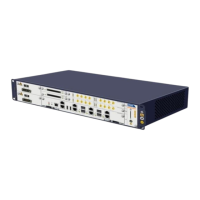Chapter15NetworkLayerDetection
RunthefollowingcommandonR1totestconnectivity.Theexecutionresultis
displayedasfollows:
R1#pingmplspseudowirepw1
sending5,120-byteMPLSecho(es)to10.28.0.4,timeoutis2second(s).
Codes:'!'-success,'Q'-requestnotsent,'.'-timeo
ut,
'L'-labeledoutputinterface,'B'-unlabeledoutputinterface,
'D'-DSMapmismatch,'F'-noFECmapping,'f'-FECm
ismatch,
'M'-malformedrequest,'m'-unsupportedtlvs,'N'-norx
label,
'P'-norxintflabelprot,'p'-prematureterminationofLSP,
'R'-transitrouter,'I'-unknownupstreamindex,'X'-unkno
wnreturncode,'x'-returncode0
'd'-DDMAP
!!!!!
Successrateis100percent(5/5),round-tripmin/avg/max=2/2/2ms.
15.8ConguringLSPTrace
Overview
lDescriptionofLSPTrace
TomakeroutersontheInternetreporterrorsoftheMPLSLSPdataplaneorprovide
informationonunexpectedconditions,theMPLStracefunctionisprovided.MPLS
traceisasimpleandeffectivemethodofdetectingfaultsontheMPLSLSPdataplane.
Itcandetectsomefaultsthatthecontrolplanecannotnd.Byusingthismethod,
userscanquicklyndandisolatefaultssuchasroutingblackholesandlossofroutes.
LSPtraceisbasedonEchoRequestandEchoReplypackets.Thepacketssentare
UDPpacketswhoseportnumberis3503insteadofICMPpackets.
LSPtraceusestheTTLeldinanMPLSpacketheader.TheLSPtracecommand
incrementstheTTLvaluefrom1,andsendsanMPLSEchoRequestpackettothe
nexthop.WhendetectingthatTTLexpires,anLSRsendsanMPLSEchoReply
packettothesource.Insuchaqueryprocedure,eachhopofanLSPcanbetraced.
lWorkFlowofLSPTrace
TheLSPtracefunctioncanbeusedtodetectdifferentFECs(IPv4LDPandRSVP).
AnLSPtracerequestpacketisaUDPpacketwithalabel.Thepacketusesthe
well-knownport3503asthedestinationport.Thesourceportisdesignatedbythe
sender.TheIP-layersourceaddressistheIPaddressofthesender.Thedestination
addressis127.0.0.1,whichisusedtopreventthepacketfrombeingforwarded
accordingtoanIProutewhenafaultoccursonanLSPofanintermediateLSR.
TheprincipleofLSPtraceisshowninFigure15-13.
15-21
SJ-20140504150128-007|2014-05-10(R1.0)ZTEProprietaryandCondential

